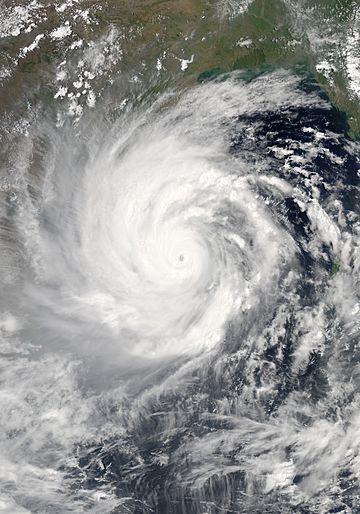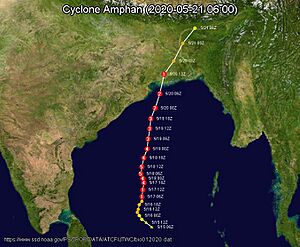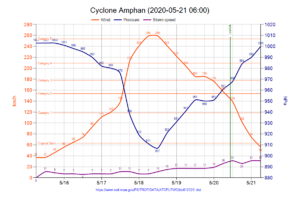Cyclone Amphan facts for kids
| Super cyclonic storm (IMD scale) | |
|---|---|
| Category 5 tropical cyclone (SSHWS) | |

Amphan near peak intensity over the Bay of Bengal on May 18
|
|
| Formed | 16 May 2020 |
| Dissipated | 21 May 2020 |
| Highest winds | 3-minute sustained: 240 km/h (150 mph) 1-minute sustained: 260 km/h (160 mph) |
| Lowest pressure | 925 hPa (mbar); 27.32 inHg |
| Fatalities | 118 total |
| Damage | > $13.35 billion (2020 USD) (Costliest on record in the North Indian Ocean) |
| Areas affected | Sri Lanka, India (Andaman Islands, Odisha, West Bengal), Bangladesh, Bhutan |
| Part of the 2020 North Indian Ocean cyclone season | |
Super Cyclonic Storm Amphan was a very powerful tropical cyclone that caused a lot of damage in East India and Bangladesh in May 2020. It was one of the strongest storms to hit the Bay of Bengal in many years. Amphan caused over US$13 billion in damage. It also led to the deaths of 118 people. This made it the most expensive cyclone ever recorded in the North Indian Ocean. It was also the strongest cyclone to hit the Ganges Delta since Cyclone Sidr in 2007.
The storm started forming on May 16, 2020, in the Bay of Bengal. It then moved towards the Ganges Delta region. Amphan finally weakened and disappeared on May 21, 2020.
Contents
What is a Tropical Cyclone?
A tropical cyclone is a huge, spinning storm system. It forms over warm ocean waters. These storms are known by different names around the world. In the Atlantic and Northeast Pacific, they are called hurricanes. In the Northwest Pacific, they are typhoons. In the South Pacific and Indian Ocean, they are called cyclones.
Tropical cyclones bring very strong winds and heavy rainfall. They can also cause storm surges. A storm surge is when the sea level rises much higher than normal. This can flood coastal areas.
Amphan's Journey and Strength
How Amphan Formed
Cyclone Amphan began as a low-pressure area. This happened over the southeastern Bay of Bengal. Warm ocean waters helped it grow quickly. It became a deep depression on May 16. Soon after, it was named "Amphan."
Growing Stronger
Amphan quickly gained strength. On May 17, it became a very severe cyclonic storm. By May 18, it turned into a "super cyclonic storm." This is the highest category for cyclones in the North Indian Ocean. At its strongest, Amphan had winds of about 260 kilometers per hour (160 miles per hour).
Path and Landfall
Amphan moved north-northeast across the Bay of Bengal. It headed straight for the coasts of West Bengal, India, and Bangladesh. On May 20, Amphan made landfall. This means it hit the land. It struck near Bakkhali, West Bengal. When it hit, its winds were still very strong.
Impact and Damage
Damage in India
Amphan caused widespread destruction in India. The state of West Bengal was hit the hardest. Many areas, including the capital city of Kolkata, suffered severe damage. Strong winds uprooted thousands of trees. They also knocked down electricity poles. This led to power outages for millions of people.
Houses, especially those with weak structures, were destroyed. Farmlands were flooded with saltwater. This damaged crops and made the soil unusable for a long time. Coastal towns faced severe flooding from storm surges.
Impact in Bangladesh
Bangladesh also experienced significant damage. Coastal districts were heavily affected. Many villages were flooded. Embankments, which are walls built to hold back water, were broken. This allowed saltwater to rush into homes and farms.
Thousands of homes were damaged or destroyed. Fishing boats were wrecked. Many people had to leave their homes and move to shelters. The storm also affected the Sundarbans mangrove forest. This forest acts as a natural barrier against storms.
Rescue and Relief Efforts
Governments and aid organizations quickly started rescue operations. Teams worked to clear fallen trees and restore power. Food, water, and other supplies were given to affected communities. Many people were moved to cyclone shelters before the storm hit. This helped save many lives.
Leaders like Prime Minister Narendra Modi visited the affected areas. They promised help and support for rebuilding.
Images for kids
-
Prime Minister Narendra Modi chairing a high-level meeting to review the response measures against cyclone Amphan, in New Delhi on 18 May 2020.
-
Amphan approaching East India and Bangladesh on 19 May
-
Prime Minister Narendra Modi making an aerial survey of Cyclone Amphan affected areas of West Bengal on 22 May 2020.
-
Prime Minister Narendra Modi with West Bengal Chief Minister Mamata Banerjee, held a review meeting after the aerial survey of the Cyclone Amphan affected areas of West Bengal, in Basirhat on 22 May 2020.
See also
 In Spanish: Ciclón Amphan para niños
In Spanish: Ciclón Amphan para niños











